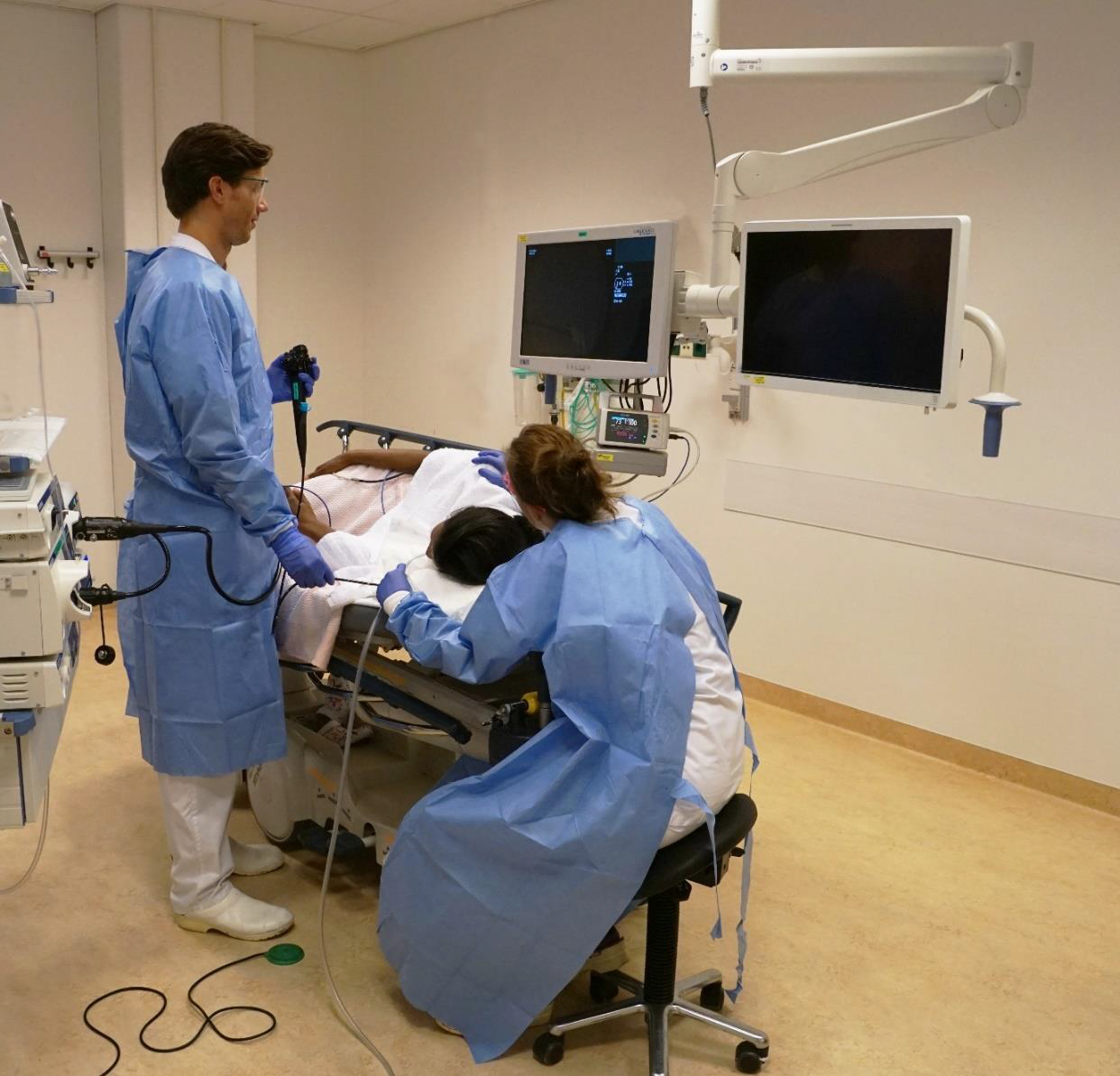Gastroscopy (English) (MDL)
This information has been prepared by the department(s) of Gastroenterology and Hepatology
Wat is Gastroscopy (English) (MDL)?
A gastroscopy is a visual examination of the esophagus, stomach and beginning of the duodenum to find the cause of your complaints. The doctor will use an endoscope for this examination. This is a flexible tube with a camera and light in it. If you have abnormalities in the esophagus, stomach or beginning of the duodenum, treatment may be possible.

Hoe kunt u zich voorbereiden?
The gastroscopy can only take place when your esophagus and stomach are completely empty.
If the gastroscopy takes place in the morning, you’re not allowed to eat and drink from midnight prior to the gastroscopy.
If the gastroscopy takes place in the afternoon after 13.30h, you’re allowed to eat one toast or cracker with a cup of tea before 07.00h in the morning. After that, you’re not allowed to eat or drink until the gastroscopy is finished.
Jewelry and other valuables may be lost, it is therefore better to leave them at home.
Anticoagulants
If you use blood thinners (such as; Ascal, Plavix or the new anticoagulants), report this to your doctor or nurse practitioner. The doctor or nurse practitioner will then determine whether the blood thinner can be temporarily stopped. If you use a blood thinner that the Thrombosis Service checks (such as fenprocoumon= Marcoumar® or acenocoumarol), the Thrombosis Service must adjust the dose. In that case, you must contact the Thrombosis Service as soon as the date of the examination is known. An INR determination is required on the day of the examination and must be tested by the Thrombosis Service. If this is not possible due to the time of the examination, the INR determination will be tested in the hospital. The INR must be between 2.0 – 3.0 otherwise the examination cannot take place.
Hoe gaat het onderzoek / de behandeling in zijn werk?
In the entrance hall of the hospital your registration at the registration column is required. You will receive a ticket to scan by which you register yourself in the endoscopy department at desk 119, route 170 (C04-S). After registration you take a seat in the waiting room.
The examination with sedation (tranquilizer)
Sometimes it’s helpful to receive a tranquilizer prior to or during the examination. If so, a needle will be inserted into your arm before the examination. For this reason, you must be present 30 minutes before the examination starts.
The tranquilizer will make you drowsy and less aware of the examination. It’s not a full anesthetic, but a medicine to help you relax. Because of the tranquilizer you will stay in hospital for observation for at least 30 minutes after the examination.
If you have received a tranquilizer it is mandatory to be picked up from the recovery room, C4-S 119.
The examination
After the last preparations, the nurse will bring you to the examination room. Since the examination will take place with a flexible tube (an endoscope) with a diameter of 1cm, your throat will be sedated with a rather bitter liquid in the form of an anesthetic spray. This will make you feel the endoscope less when it passes into your throat.
False teeth must be taken out before the examination starts. If you still have your own teeth a ring will be placed in your mouth to protect your teeth and to prevent you from biting the endoscope. During the examination you will be positioned on your left side. The doctor will put the endoscope on the back of your tongue, and you will be asked to swallow firmly. It is possible to breathe throughout the whole examination, including when the endoscope is inserted into the esophagus.
When saliva accumulates in your mouth, it is possible to let it slide to the corner of your mouth. There will be a protective mat under your head. Also, the nurses will use suction to remove the saliva. During the examination the doctor will blow in air through the endoscope what can cause a full feeling in the stomach. It is important that you try to relax, and it can be very helpful to take deep breaths during the examination. The nurse will guide you through the examination.
If needed, the doctor will take a biopsy by ‘scratching’ off tissue from the inside of the stomach or esophagus. You won’t feel a biopsy being taken and the tissue will be examined later under a microscope.
The examination is very safe and not burdensome. However, there’s a small chance of a complication. For example, blood loss or a perforation. In such cases surgery can be necessary.
Duration of the examination
The examination will approximately take 15 minutes.
Waar moet u op letten direct na het onderzoek / de behandeling?
After the examination you’re not allowed to eat or drink anything for 30 minutes because of the anesthetic spray that’s been used to sedate your throat. This can cause you to choke if you do eat or drink anything. After the examination you’re allowed to go home. Except for when you’re already hospitalized or if you received a tranquilizer.
You’re not allowed to go home without guidance. After receiving a tranquilizer you’re not allowed to drive any kind of vehicle for the rest of the day.
Contact bij problemen na uw onderzoek/behandeling
In case of medical problems after the gastroscopy, please contact LUMC by calling 071-526 91 11. Ask for the gastrointestinal doctor on duty.
Contactgegevens van de betrokken poliklinieken
If you have any questions, it’s possible to contact the endoscopy department on workdays by calling the telephone number 071-526 35 75 between 9 – 11h AM or e-mail: endoscopie.mdl@lumc.nl